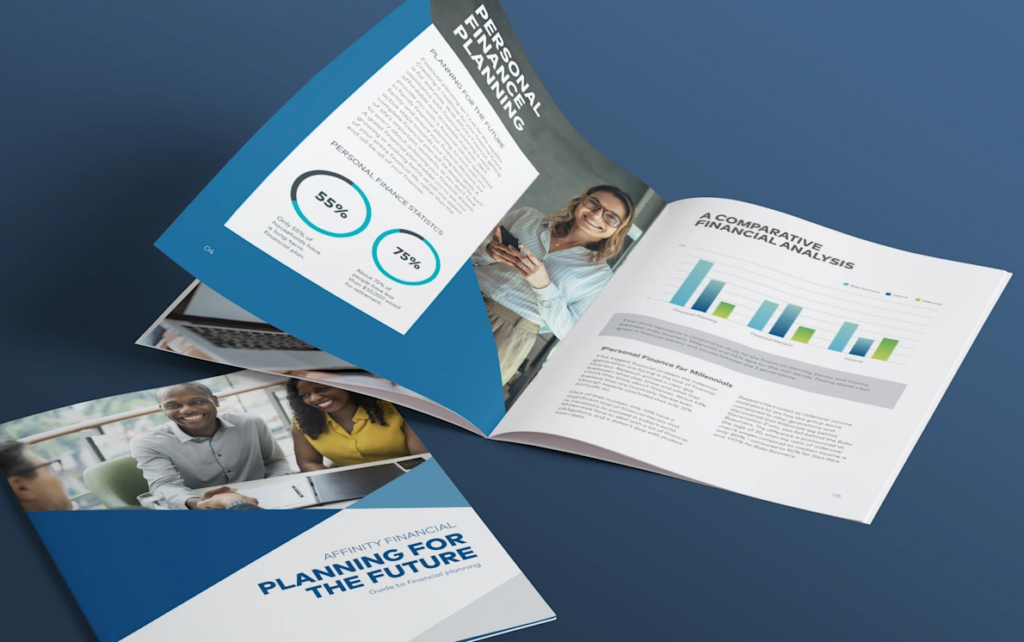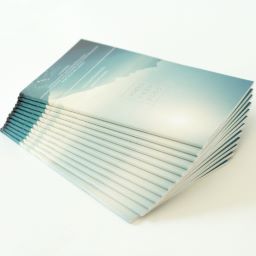The Ultimate Guide to Custom Booklet Printing for Small Businesses
The Ultimate Guide to Custom Booklet Printing for Small Businesses
Blog Article
The Important Guide to Recognizing Pamphlet Printing Options and Techniques
The process of booklet printing involves numerous considerations that can significantly influence the end product. From choosing the ideal layout and dimension to comprehending the nuances of binding methods, each selection plays a crucial role. In addition, aspects such as paper stock and printing strategies additional influence the performance of the booklet. As one browses these options, it ends up being imperative to comprehend how they adjoin and what that implies for the total result.
Recognizing Brochure Dimensions and styles
When taking into consideration brochure printing, recognizing the different layouts and sizes readily available is important for attaining the wanted presentation. Booklets can be created in countless styles, consisting of saddle-stitched, spiral-bound, and perfect-bound, each offering distinct benefits. Usual sizes vary from standard letter (8.5 x 11 inches) to smaller alternatives like A5 (5.8 x 8.3 inches), permitting versatility based upon content and target audience.Selecting the proper dimension can influence both the layout and visitor involvement. Larger sizes may match aesthetically driven content, while smaller styles might be more portable and easy to use. Additionally, the number of pages impacts the selection of binding approach, as thicker booklets may need stronger bindings. Eventually, recognizing these facets enables a more tailored method, making sure that the last item straightens with the desired message and visual, enhancing the overall effectiveness of the communication.
Choosing the Right Paper Stock

Binding Methods: Factors To Consider and alternatives
When it concerns binding approaches for brochures, several options are available, each with unique advantages. Saddle stitch binding provides a cost-effective option for thinner booklets, while best binding methods provide an even more refined try to find thicker publications. Wire-O binding attracts attention for its durability and simplicity of use, making it suitable for documents that need flexibility.
Saddle Stitch Binding
Saddle stitch binding offers a useful and cost-effective service for putting together booklets, making it a popular selection amongst publishers and companies. This binding technique includes folding sheets of paper in fifty percent and stapling them along the fold line, creating a well organized and cool look. Usually appropriate for pamphlets with a lower web page matter, saddle sewing is suitable for magazines, brochures, and training materials. The simplicity of this technique permits for fast manufacturing and is usually favored for brief runs or advertising items. However, it is vital to keep in mind that saddle stitch binding might not be ideal for thicker booklets, as the spinal column may not stand up under raised weight. Overall, it stays a dependable choice for lots of printing jobs.
Perfect Binding Methods
Perfect binding is an extensively utilized technique that offers a professional and refined finish to magazines and brochures. This technique includes gluing the pages with each other at the spinal column making use of a strong adhesive, allowing for a clean side and the capacity to hold a bigger number of web pages compared to saddle stitching. Perfect binding is especially ideal for thicker booklets, such as brochures and annual reports, where a tough, flat back is desired. In addition, it uses the choice for a published cover that can be designed to improve aesthetic appeal. Factors to consider such as web page count, paper weight, and the meant usage of the brochure ought to be taken right into account, as they can affect sturdiness and general top quality.
Wire-O Binding Options
Wire-O binding, recognized for its sturdiness and flexibility, provides an excellent alternative for booklets that require very easy page turning and an expert appearance. This binding technique utilizes a collection of metal loops that hold pages securely, allowing them to exist flat when open. It is especially ideal for catalogs, manuals, and presentations as a result of its robust nature. Wire-O binding is offered in numerous shades and diameters, fitting different web page matters and thicknesses. Additionally, it permits the inclusion of tabs and covers, improving the brochure's total aesthetic. Factors to consider for Wire-O binding include the selection of cord shade, the size of the loopholes, and the level of modification wanted, all of which can profoundly influence the final product's look and functionality.
Digital vs. Offset Printing: Which Is Best for You?
When picking a printing method for booklets, understanding the distinctions in between digital and offset printing is essential. Digital printing utilizes modern-day technology to create high-quality prints quickly and economically, making it ideal for brief runs or tasks requiring quick turnaround times. It enables modification, supplying the capability to print on-demand with marginal waste.In contrast, balance out printing is a typical approach that stands out in creating big amounts with regular top quality. It entails transferring ink from a plate to a rubber covering, after that to the paper, which leads to accurate details and lively shades. Counter printing commonly needs longer arrangement times and is a lot more economical for larger volumes.Ultimately, the choice between digital and balance out printing depends on project demands, spending plan, and wanted quantity. For small, time-sensitive tasks, digital could be the very best choice, while balanced out may be more suitable for larger, premium manufacturings.

Creating Your Pamphlet: Tips and Best Practices
When creating a pamphlet, mindful focus to layout, font style selection, and shade use can greatly improve its efficiency. A well-structured format guides the visitor's eye, while proper font styles guarantee readability and communicate the preferred this tone. Furthermore, efficient use of shade can evoke emotions and highlight key info, making the total design extra impactful.
Choosing the Right Design
Exactly how can one properly select the best layout for a booklet? First, it is important to review the pamphlet's function and target audience. A clean, arranged design enhances readability and interaction. Utilizing a grid system can aid in straightening components regularly, producing an expert look. Additionally, incorporating visual pecking order through varying dimensions and placements of photos and text can assist the viewers's eye and highlight vital information. It is likewise crucial to leave enough white space, which avoids congestion and allows for far better emphasis. Testing various layouts through mock-ups can supply insight into just how the style does in real-world situations, making sure that the final item fulfills both practical and aesthetic needs.
Picking Suitable Font Styles
A well-chosen typeface can greatly enhance the overall design of a pamphlet, complementing the design and reinforcing the material's message. The choice of font styles ought to think about readability, particularly for body text, as it guarantees the details comes to all readers. Sans-serif fonts are often favored for electronic layouts, while serif typefaces can offer a standard feel in published materials. It's suggested to restrict font choices to two or 3 to keep aesthetic coherence. Furthermore, typeface size plays a vital duty; headings must be distinct however not frustrating, while body message should be comfy for analysis. When picking font styles, positioning with the booklet's theme and target audience is important for reliable communication and visual allure.
Efficient Use Color
Shade works as an effective device in pamphlet style, leading and shaping perceptions reader emotions. It can stimulate feelings of trust fund, calmness, or enjoyment, depending upon the colors picked. Designers should think about shade concept principles, making sure that the selected scheme aligns with the pamphlet's message and target audience. For example, utilizing cozy colors like red and orange can develop seriousness, while cooler tones like eco-friendly and blue foster tranquility.Additionally, contrast plays an essential duty; corresponding shades can boost readability and aesthetic appeal. Consistency in shade usage throughout pages further enhances brand identification and cohesion. Eventually, reliable shade implementation not only catches interest yet additionally enhances the brochure's function, making it an important aspect of successful design.
Completing Touches: Coatings and Special Results
While many consider Related Site the material and layout of a brochure the most critical components, the completing touches, such as finishes and unique impacts, play a crucial duty in improving its overall appeal. Coatings can give protection and durability, ensuring that the booklet endures deterioration. Matte surfaces supply an advanced, non-reflective surface, while glossy coverings can make colors show up more dynamic and distinctive. Unique effects, like embossing or foil stamping, add a tactile dimension that can produce a remarkable perception. These methods can highlight specific areas, drawing attention to essential details or producing aesthetic rate of interest. Additionally, UV layer can offer a high-shine coating that boosts the total look.Together, these finishing touches not just improve the pamphlet's aesthetic but likewise connect professionalism and trust and focus to information, inevitably leaving a long-term effect on the visitor.
Cost Considerations for Brochure Printing
Recognizing the numerous cost factors to consider for booklet printing is vital for organizations and services intending to maximize their budget plans. Secret elements influencing prices include the choice of paper, binding, and ink methods. Better materials, such as superior paper or specialized inks, usually boost the total expenditure. In addition, the dimension and page matter of the booklet play a significant role; bigger pamphlets require more sources and time to produce.Another important factor to consider is the printing strategy, whether digital or offset, as each has its own prices framework and suitability for different amounts. Companies must additionally consider layout expenses, which can differ based on intricacy and the usage of professional solutions. Ultimately, delivery and handling charges can include to the total, particularly for huge orders. By reviewing these elements, organizations can make educated choices that line up with their monetary abilities while attaining the desired high quality in their published products.
Regularly Asked Questions
What Are the Ecological Impacts of Booklet Printing?
The environmental influences of booklet printing include deforestation from paper production, carbon discharges from transport, and waste generation from disposed of products - Booklet Printing. Sustainable techniques, such as making use of recycled paper and eco-friendly inks, can alleviate these impacts
Exactly How Can I Guarantee Color Accuracy in My Booklet?
To ensure color precision in a brochure, one ought to make use of adjusted displays, utilize professional shade accounts, conduct test prints, and pick high-grade printing services that use color matching and proofing options for finest results.
What Is the Typical Turnaround Time for Pamphlet Printing?
The common turnaround time for pamphlet printing differs depending on the intricacy and amount - Booklet Printing. Generally, it varies from a few days to two weeks, influenced by aspects such as publishing techniques and finishing needs
Are There Minimum Order Quantities for Booklet Printing?

Can I Publish Booklets in Numerous Languages?
Publishing brochures in multiple languages is possible. Many printing solutions supply choices for multilingual or multilingual layouts, allowing for effective interaction. Cautious planning warranties that create components suit various languages without jeopardizing readability or appearances. Additionally, elements such as paper supply and printing techniques additional affect the effectiveness of the booklet. When considering pamphlet printing, understanding the numerous layouts and sizes offered is crucial for achieving the preferred presentation. When selecting a printing technique anonymous for booklets, comprehending the distinctions between digital and counter printing is essential. Additionally, the dimension and web page matter of the booklet play a significant duty; larger pamphlets call for even more sources and time to produce.Another essential consideration is the printing technique, whether digital or countered, as each has its very own prices framework and suitability for various quantities. The environmental effects of booklet printing include deforestation from paper production, carbon exhausts from transport, and waste generation from thrown out materials.
Report this page